Roman Coinage › The Importance of the Lydian Stater as the World's First Coin » Origins and History
Articles and Definitions › Contents
- Roman Coinage › Ancient History
- The Importance of the Lydian Stater as the World's First Coin › Antique Origins
Ancient civilizations › Historical places, and their characters
Roman Coinage › Ancient History
Definition and Origins
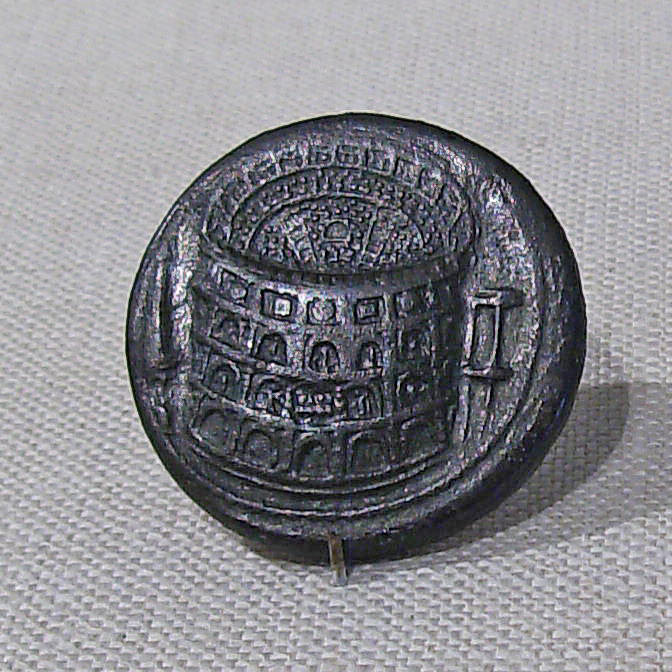
Roman coins were first produced in the late 4th century BCE in Italy and continued to be minted for another eight centuries across the empire. Denominations and values more or less constantly changed but certain types such as the sestertii and denarii would persist and come to rank amongst the most famous coins in history.
Roman coinage, as in other societies, represented a guaranteed and widely recognised value which permitted an easy exchange of value which in turn drove both commerce and technology development as all classes could work to own coins which could be spent on all manner of goods and services. Even more significantly, large and identical payments could now be easily made which made possible a whole new scale of commercial activity. Coins also had a function as a vehicle to spread the imagery of the ruling class as coinage was the mass media of the day and often carried likenesses of emperors and famous imperial monuments which would be the nearest most Romans ever got to see of them.
COINS OF THE REPUBLIC
The early Republic did not use coins but rather a system of bronze weights, the aes rude. These units were quite large as one unit was the equivalent of 324 g. or 11 1/2 oz. in weight. Despite their heaviness, this type continued to be produced up to c.218 BCE. As the Romans expanded over central Italy war booty meant coins could be produced using precious metals - gold, silver, and bronze. The first Roman coins were probably the small bronze ones of low value produced at Neapolis from 326 BCE and carried the legend PΩMAIΩN. The first silver coins were produced from the early 3rd century BCE and resembled contemporary Greek coins. These were worth two Greek drachmas and carried the legend ROMANO, later to become ROMA. Gradually, following the financial excesses of the Punic Wars, the weight of coins was reduced, as was the metal content of the bronze bars. Due to financial necessity, gold coins (aurei) were also minted, a rare event not to be repeated until the 1st century BCE.
In c. 211 BCE a whole new coinage system was introduced. Appearing for the first time was the silver denarius (pl. denarii), a coin that would be the principal silver coin of Rome until the 3rd century CE. The coin was initially funded by a tax on property but then via war booty as the wars against Carthage swung in Rome's favour. The denarius was equal to 10 bronze asses(sing. as ), each of which weighed 54 g. or 2 oz. There were other coins such as the silver victoriatus which was in weight equal to three quarters of a denarius, the quinarii, worth half of a denarius, and other bronze and gold coins but these were not always widely or consistently used. From c. 200 BCE only Rome now produced coins in Italy and the movement of troops ensured the wider circulation of Roman coinage.
IN 46 BCE JULIUS CAESAR MINTED THE LARGEST QUANTITY OF GOLD COINS YET SEEN IN ROME.
As Rome expanded and took ever more treasure from her enemies silver began to replace bronze as the most important material for coinage. This was especially so following the acquisition of the silver mines of Macedonia from 167 BCE, resulting in a huge boom in silver coins from 157 BCE. In addition, in c. 141 BCE the bronze as was devalued so that now 16 were equivalent to one denarius. It was now no longer necessary to mark coins as Roman as there were no others in Italy and by the 1st century BCE Roman coins were now also being widely used across the Mediterranean.
In 84 BCE once again the link between warfare and coinage was evidenced when Sulla minted new silver and gold coins to pay his armies, a necessity repeated by Julius Caesar, who in 46 BCE, minted the largest quantity of gold coin yet seen in Rome, outproducing the state mint in the process. Following the death of Caesar coinage was produced by the various parties fighting to succeed him but with Octavian 's victory a uniform Roman coinage was once more established.
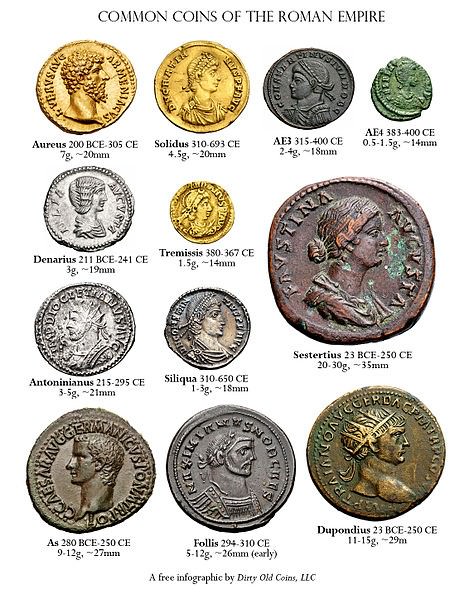
Roman Coins
COINS OF THE EMPEROR
The imagery on coins took a turn towards propaganda when Julius Caesar used his own profile on his coins, an opportunity not missed by Brutus who similarly used his own image on one side of his coins and on the other side two daggers symbolising his role in the assassination of Caesar. Augustus, naturally, followed suit but he also reformed the denominations of smaller coins and his new system would form the basis of Roman coinage for the next three centuries. Gone were the silver coins below the denarius to be replaced in 23 BCE by the brass ( copper and zinc) orichalcum sestertius and dupondius (pl. dupondii), and the as and the even smaller quadran (quarter) were now made from copper instead of bronze. The silver denarius continued as before (now valued 84 to the pound) and the gold aureii were valued at 25 denarii each and 41 to the pound (7.87 g). Coins were largely struck in Rome but a significant exception was the Lugdunum mint which started production (mostly gold and silver coins) in 16 BCE and dominated until the mid 1st century CE. Other notable mints, albeit with sporadic production, were in Lyon in Gaul and the cities of Antioch, Alexandria and Caesarea, amongst others. It is also worth noting that in the east local varieties persisted, especially low value bronze coinage.
Following the Severan emperors coin production began to proliferate throughout the empire. Hundreds of individual cities across the empire also minted their own coins and the forms of smaller denominations, in particular, were left to local authorities but in general all of these provincial varieties were convertible to Roman coin values. It was also probable that these various coins remained within their own geographical area as empire wide circulation was not guaranteed and although Rome-minted coinage was shipped to provinces it is more than likely that it remained there.
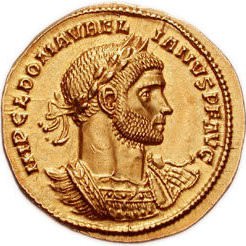
Coin Depicting Roman Emperor Aurelian
THREATS TO THE CURRENCY
Coins were continuously minted as taxation only met 80% of the imperial budget and the shortfall was met by putting more coins into circulation, the source coming from freshly mined metal. This also meant that extravagant emperors could get themselves into serious financial trouble. One solution was to reduce the weight and or the metal content of coins and so increase the possible money supply. Nero did this in 64 CE (reducing gold content by 4.5% and silver by 11%) as did Commodus, Septimius Severus and Caracalla, who produced the antoninianus which perhaps had the face value of two denarii whilst only really being worth nearer one and a half. Gradually, silver coins went from pure to 50% and then on down until they reached an all time low of just 2% silver content. There is even evidence in the later empire that low-content silver coins were deliberately given a finer silver surface to make them appear more valuable than they were. Such blatant manipulation of currency did not go unnoticed by the general population who retaliated by paying their taxes using the newer coins and keeping the older more valuable ones for savings or even melting them down.
THERE WAS A SPECIFIC BODY OF PROFESSIONALS (NUMMULARII) WHO HAD THE TASK OF TESTING SUSPECT COINAGE.
Another problem was the production of forged money, largely helped by the poor quality of the official coinage. There was a specific body of professionals ( nummularii ) who had the task of testing suspect coinage but they were overwhelmed by the flood of fake coins. The situation became even graver following the barbarian invasions of the 3rd century CE and the resulting financial pressure on the empire led to the collapse of the silver currency so that only the gold coinage and goods in kind kept the economy afloat.
From Aurelian attempts were made to improve the situation with coins being stamped to indicate their metal content: XXI or KA for 5% silver and XI or IA for 10 %. In 293 CE Diocletian continued the reforms by guaranteeing the gold content of the aurei at 60 to a pound (later renamed the solidus and which would actually outlast the empire itself), minted a new pure silver coin and a part silver bronze coin, the nummus (worth 1/7200 of a solidus). He also further reassessed values in 301 CE, restricted production to between 12 and 15 mints, and made all designs and legends the same across the empire, wherever they were minted. Constantine reversed the trend by devaluing the solidus so that 72 equalled the pound but the economy bore the change. In general, bronze coins came to the fore in the later empire with their denominations varying over time and further reforms continued so that the stability of earlier centuries was never quite recaptured and production of coinage in the West ceased around 480 CE.
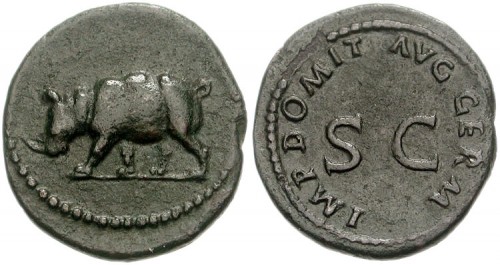
Imperial Roman Coin Portraying a Rhinoceros
IMAGERY
Images were made on coins by striking the coin by hand onto a pre-cut die placed below (obverse) and above (reverse) the blank coin. In the Republic, control of state coinage was in the hands of three junior magistrates (later to be four), the tresviri aere argento auro flando feriundo or aaaff. They often signed their issues and initially favoured such classic images as Roma, Jupiter, Mars and Victory. In the second century BCE a series of coins depicted a quadriga or four-horse chariot but from c.135 BCE the tresviri metales began to stamp references to their own family history, local landmarks, contemporary events and perhaps even their political allegiance. The representation of rulers was avoided, perhaps because on Greek coins this had been for kings and tyrants and so was not in accordance with the principles of a republic. Legends were in vertical or horizontal lines not curving around the edge and could continue on to the opposite side of the coin.
PORTRAITS COULD VARY FROM AN IDEALISED TO VERY REALISTIC REPRESENTATION DEPENDING ON PARTICULAR EMPERORS.
Imperial period coins typically have on the obverse side a portrait of the emperor - now in sole charge of the state treasury - usually in profile wearing either a radiant crown or crown of laurel leaves, or, more rarely, a member of the imperial family.Portraits could vary from an idealised to very realistic representation depending on particular emperors, the stage of their reign and changing artistic trends. After Constantine imperial portraits became increasingly standardised and a more uniform representation of the emperor regardless of individual physical characteristics became the norm. A notable exception to using the emperor was the SC ( Senatus Consulto ) stamped on Augustan coppers, perhaps signifying senatorial backing. Legends now ran clockwise around the coin, always starting from the bottom left.
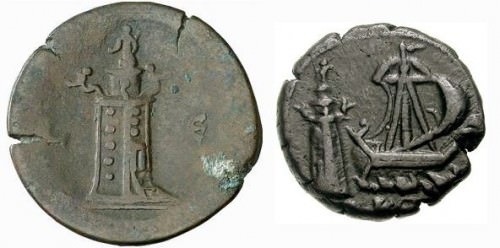
Alexandrian Coins Depicting the Lighthouse of Alexandria
CONCLUSION
In many cases, coins offer the only physical likeness of prominent personalities in the history of Rome. They also depict lost or ruined monuments and help to establish both the precise chronology of Rome and the date of other artefacts that might accompany them in archaeological finds. Coins of certain date can also help to date other less certain coins when they are found together. Coin portraits have also contributed invaluably to naming previously unidentified portrait sculpture and the distribution of coins across the empire can also reveal much about population movements, trade networks and civic identity. All of these studies continue to develop over time as ever more coin hoards are randomly discovered in out of the way places across territory once part of the Roman Empire.
The Importance of the Lydian Stater as the World's First Coin › Antique Origins
Ancient Civilizations
The Lydian Stater was the official coin of the Lydian Empire, introduced before the kingdom fell to the Persian Empire. The earliest staters are believed to date to around the second half of the 7th century BCE, during the reign of King Alyattes (r. 619-560 BCE). According to a consensus of numismatic historians, the Lydian stater was the first coin officially issued by a government in world history and was the model for virtually all subsequent coinage.
BACKGROUND ON ANCIENT COMMERCE
Chiefly, in order for a coin to be legitimately considered such, it must clearly be issued by a governing authority. This distinguishes coins from tokens, barter items, and other limited forms of money. Though there are no requirements that a coin be made of metal, this is largely unavoidable for the coin to function as money (as a unit of account, an intermediary of exchange, and a store of value), as it must be portable, non-perishable, difficult to counterfeit, and confer value (whether intrinsically or by decree). Nineteenth-century historian Barclay V. Head observed that “the precious metals had long...commended themselves to the civilized peoples of the East as being the measure of value least liable to fluctuation, most compact in volume, and most directly convertible.”
Gold and silver were used as currency, as a means of facilitating commercial exchange, long before the first coins arose.Rings or ingots (bars) of precious metal were used by travelers and traders across the ancient world, but they had to be weighed and verified each time a transaction took place in order to reckon their value in trade. Coins, with their standardized weights, eliminated this time-consuming problem, rendering them a more efficient and expedient conduit of commerce.
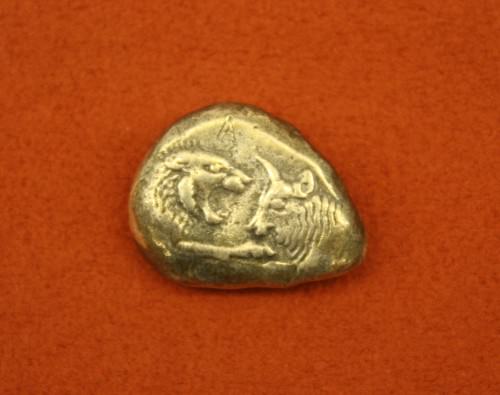
Lydian Silver Stater
It is fitting, and worth observing, that the Lydians engendered a mercantile culture; Herodotus acclaimed them (with exaggeration) as the world's first merchants, as they earned a reputation for being important interlocutors between East and West. In his monograph The Coinage of Lydia and Persia, Barclay Head noted “the spirit of commercial activity which the natives of Lydia possessed,” while another 19th-century historian, Ernst R. Curtius, compared their knack for playing middlemen to that of the Phoenicians : "The Lydians became on land what the Phoenicians were by sea, the mediators between Hellas [ Greece ] and Asia." With its strategic territorial expansion near the Bosporus and Hellespont (now the Dardanelles Strait), which effectively connect the Black Sea to the Aegean Sea, it is no surprise that the Lydian Empire of the late 7th - early 6th century BCE would be home to a thriving mercantile tradition. The Lydians even gave special status to merchants within their society: they were known as agoraios, or “People of the Market,” and enjoyed a higher rank than commoners in the social hierarchy.
It is, however, unclear that the earliest staters of Lydia actually circulated in commercial exchange. In archaeological sites near Sardis, for instance, there are no staters found in the ruins of shops and marketplaces. One would expect to find them here if they were spent as money within the kingdom. More likely, these coins were hoarded by the king and the wealthy, perhaps issued for the collection of taxes, and used in long-distance trade between Lydia and its neighbors, as many staters have been recovered from Ionian temples.
A NOTE ABOUT HISTORICAL CONSENSUS
There are, however, competing historical theories about the first government-issued coins arising earlier in Greece, India, or China. In the latter two cases, most historians have concluded that although coinage likely sprung up in China and India independently from Lydia, the evidence suggests that these developments took place after the introduction of the stater. The case for Greece seems to owe itself largely to the Western bias of more contemporary historians. Nonetheless, it reveals that the true genesis of coins as money remains a disputed topic of historical inquiry.
COMPOSITION & APPEARANCE OF LYDIAN COINS
The Lydian stater was composed of electrum, a naturally-occurring gold-silver alloy; though the coins are often reported to be struck from this naturally-occurring alloy, they were actually made from a specific and rather consistent mix of approximately 55% gold, 45% silver, and a small balance of copper. This indicates that silver and copper were added to natural electrum in order to achieve a more durable and balanced metal alloy. Although the extra copper slightly debased the coin's intrinsic value, it allowed it to exhibit a golden hue, unlike the pale white-gold color of pure electrum.

Electrum Sixth Of A Stater
There do exist cruder pieces struck in electrum that possibly predate the stater. These first electrum “pre-coins” were blank, bearing no emblem that tied them to an issuing authority. They sometimes featured striations on one side of the flan, which historians have speculated may harken to the electrum-rich Pactolus River that supplied the raw materials for these pieces.(The Pactolus was said to have acquired its metallic abundance when King Midas of nearby Phrygia bathed in its waters to remove his curse of the “golden touch.”) It appears, however, that many of the Asiatic Greek cultures -- especially in Miletus (or Miletos) and Ionia, along the Aegean coast -- were using, or perhaps experimenting with, these electrum blanks contemporaneously with the Lydians. It is the administrative innovations of Alyattes and his son Croesus (or Kroisos) which set the Lydian staters apart.
For numismatists and numismatic historians, the importance of Lydian coinage is the novel idea that striking or stamping a piece of precious metal with a “State seal” of sorts could confer official status on it as money, indicating the State's willingness to accept the piece as payment. This is the crucial feature that distinguishes Lydian staters from preceding forms of money and connects them to all subsequent coins.
Staters came in somewhat irregular shapes, many of them ovular or bean-shaped, but had a fairly consistent weight of 220 grains of wheat. (This measure is somewhat complicated by the variance between the wheat grains, barleycorns, and carob seeds that formed the basis for different weight standards in antiquity.) This weight is what defined a “stater.” In fact, all ancient coin “units” or denominations -- such as shekels, drachms, and the like -- were expressions of units of weight rather than a specific value. The term “stater,” for instance, was used generically around ancient Greece to mean “that which balances scales.”
The coins were minted in Sardis (or Sardes ), the Lydian capital, with an unmistakable design that represented the city : the foreparts of a lion (on the left) and a bull (on the right) facing one another. Smaller varieties only use the right-facing lion protome with a small sunburst above that many modern observers mistook for a “nose wart.” The image was created by a punch, as evidenced by the two incuse squares located on the reverse of the coin. This design is of crucial importance, not only in its Assyrian symbolism, but also for its identifying presence. The use of the “Lydian Lion” hallmark showed that these coins were official tender of the king in his kingdom, an idea that we do not see employed in the ancient world prior to Lydia.Rather quickly, however, other kingdoms and empires adopted the same seigniorage scheme as Alyattes had, and Croesus built upon after him.
The most common fractional coin within this system was the third-stater, or trite, which -- just as it sounds -- was one-third the weight of the stater. Some sources have surmised that the value of a third-stater amounted to a month's subsistence; others have placed its monetary worth somewhat lower. In addition to thirds, there were also sixth-staters, twelfth-staters, as well as staters in fractions of 1/24, 1/48, and 1/96.
Following the success of the Lydian stater, many of the surrounding cultures of Anatolia and Hellas began to imitate the Lydian model, issuing for circulation their own electrum coins stamped with the respective city-state ’s hallmark, or some identifying emblem. After Croesus introduced the first bi-metallic coin standard, with highly pure gold and silver coins, the Greeks capitalized upon the notion and adapted their own system of silver coinage based on the drachm. It is most likely the Greek Ionians who took the Lydian invention of the coin and applied it to the retail market with its smaller silver coins.
LEGACY OF THE LYDIAN STATER
As mentioned above, King Croesus (r. 560-547 BCE), Alyattes' successor, decided to improve upon the electrum coin by introducing highly pure gold and silver staters. These coins had the advantage of a more definite intrinsic value of their underlying metals, whereas electrum's worth was more difficult to calculate due to the mix of metals.
While serving as viceroy for his father Alyattes in the northwestern part of the Lydian Empire, Croesus undoubtedly observed the spread of gold pre-coins coming from the eastern kingdoms of Media and Babylonia. It is believed that this experience enlightened him to the potential that a circulating gold stater had to increase the influence and power of Lydia overseas, especially with her Greek trading partners. Although there is some dispute about this coinage reform taking place late under Alyattes' reign rather than under Croesus', historical consensus ascribes the development to Croesus, even classifying the staters of this period as croesid.

Lydian Gold Stater
The new gold and silver creosid coins replaced the electrum issues. They were still broken into the same fractional denominations, though the new gold staters weighed 126 grains and the silver staters weighed 168 grains. In this manner, a convenient exchange rate of ten silver staters to one gold stater was retained. The importance of this exchange standard should not be overlooked, as it reveals that Croesus took great care to produce coinage that could be used internationally.Minting coins with a familiar and uniform exchange rate--giving them an international character--contributed to the expansion of Lydia's imperial reach, especially by the time of Croesus when the territories on the west coast of Asia Minor had (for the most part, peacefully) been incorporated into the Lydian Empire as vassal states.
At the height of Lydia's power in the middle of the 6th century BCE, King Croesus is said to have sought the Oracle at Delphiand asked what would come of a war with Cyrus the Great of Persia. The Oracle replied that a great empire would be destroyed. Though Croesus assumed this referred to the Persian Empire, the premonition proved ironically true about his own empire, which was conquered by the invading Persians.
Even after Lydia (and the entirety of its dominion) was incorporated into the Persian Empire, the croesid coinage remained in use for some time. Such a large number of gold and silver staters of the Lydian type have been found that date from after the fall of Croesus, in fact, that many numismatic historians believe the new Persian governors of Anatolia continued to strike unaltered coinage from the same dies at the Sardis Mint for some time.
After the Lydian stater, no gold coin of the ancient world enjoyed quite the same diffusion and recognition until the gold daricissued by Darius the Great of Persia emerged shortly before the beginning of the 5th century BCE. Among both people of antiquity and contemporary numismatists, the daric acquired the nickname “Archer” for bearing the image of the warrior king holding a bow and arrow. Nonetheless, the electrum, gold, and silver staters of Lydia are without comparison in any discussion on the origin of coins.
LICENSE:
Article based on information obtained from these sources:with permission from the Website Ancient History Encyclopedia
Content is available under License Creative Commons: Attribution-NonCommercial-ShareAlike 3.0 Unported. CC-BY-NC-SA License